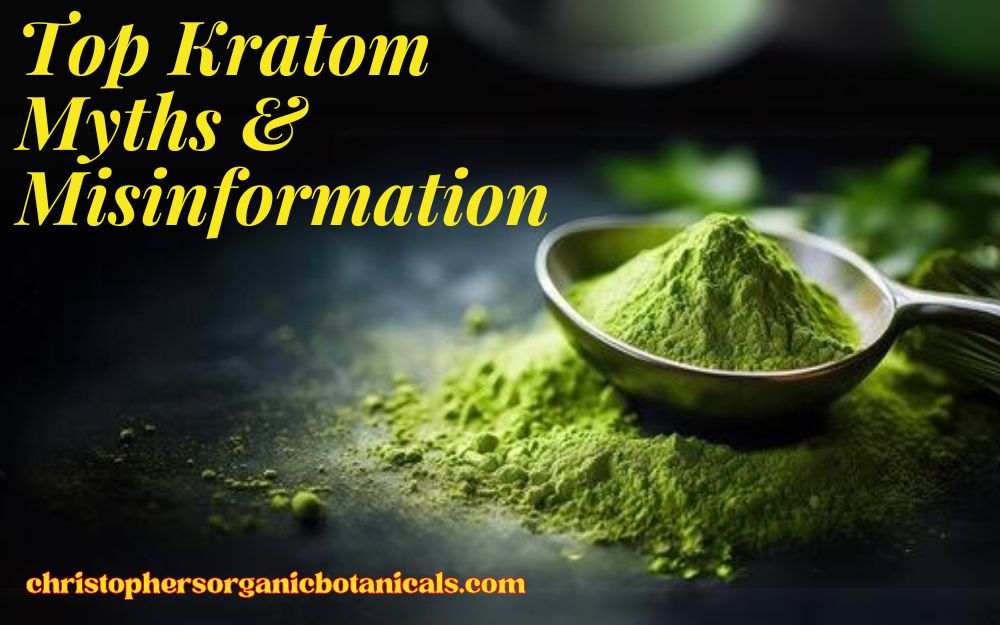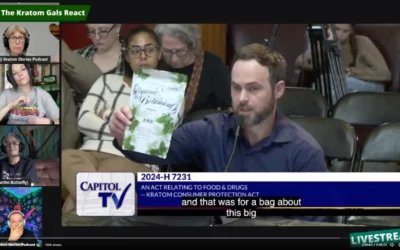There are myths and confusion about this plant. People are unsure about what it is, how it works, and if it’s safe. Below are some of the Kratom myths and misinformation we will be debunking.
Top 6 Kratom Myths & Misinformation
1. Kratom is a Synthetic Drug
Myth: Many believe that kratom is a synthetic or man-made drug.
Fact: Kratom is a natural botanical product derived from the leaves of the *Mitragyna speciosa* tree, native to Southeast Asia.
2. Kratom is an Opioid
Myth: Some claim that kratom is an opioid.
Fact: While kratom does interact with opioid receptors in the brain, it is not classified as an opioid. Its primary active alkaloid, mitragynine, produce effects that can be both stimulating and sedative, depending on the dosage .
3. Kratom Causes High Rates of Overdose Deaths
Myth: There is a widespread belief that kratom is responsible for numerous overdose deaths.
Fact: Most reports of kratom-related deaths involve the presence of other substances, such as opioids or benzodiazepines. Pure kratom use alone has not been conclusively linked to a high number of overdose fatalities .
4. Kratom is Highly Addictive
Myth: Kratom is often labeled as highly addictive.
Fact: While some users may develop a dependency, the addiction potential of kratom is generally considered to be lower than that of traditional opioids. Withdrawal symptoms are typically mild and manageable compared to those of opioids. Kratom 8 Factor Analysis from 2021.
5. Kratom has No Therapeutic Value
Myth: Some assert that kratom has no medicinal or therapeutic benefits.
Fact: Numerous anecdotal reports and emerging research suggest that kratom can be beneficial for managing discomfort, boosting energy, and enhancing mood. Ongoing studies funded by institutions such as the NIH aim to further investigate these potential benefits .
6. All Kratom Products are Unsafe
Myth: It is commonly believed that all kratom products are unsafe and unregulated.
Fact: While some kratom products on the market may be adulterated, organizations like the American Kratom Association advocate for the Kratom Consumer Protection Act (KCPA), which aims to establish safety standards and regulations for kratom products, ensuring consumer safety .
Understanding these myths and facts can help provide a clearer picture of what kratom is and its potential risks and benefits. Always consult reliable sources and consider regulatory guidelines when discussing or using kratom.
Kratom Hasn’t Been Researched
Understanding the Research on Kratom (Mitragyna Speciosa)
A common myth about Mitragyna Speciosa, commonly known as kratom, is that there is no research on its effects on the body. While it is true that research in the Western world is limited, many studies have been conducted in Southeast Asia, where kratom has been used as a traditional medicine for centuries. These studies have provided valuable insights into its various effects on the body.
In regions like Thailand, Malaysia, and Indonesia, indigenous communities have used kratom for its energizing properties and other benefits. This traditional knowledge has been supported by studies examining kratom’s chemical makeup and the effects of its alkaloids, such as mitragynine. Researchers have explored how these alkaloids interact with receptors in the brain and nervous system, contributing to our understanding of kratom’s potential benefits and mechanisms of action.
Additionally, anecdotal evidence from users around the world supports the potential benefits of kratom. While such reports are not a substitute for scientific research, they provide valuable insights that can guide future studies. Many users have shared their experiences, highlighting kratom’s possible benefits, side effects, and recommended dosages.
Overall, while more comprehensive research is needed to fully understand the risks and benefits of kratom and to establish best practices for its safe and effective use, existing studies and traditional knowledge provide a substantial foundation for ongoing exploration.
Despite limited research, mitragyna speciosa has caught the attention of scientists, doctors, and regulators in recent years. More money and attention are now being given to studying the possible benefits, safety, and dangers of kratom. Currently, numerous studies and trials are being conducted to gain a deeper understanding of kratom’s effects. These research efforts also aim to determine the potential medical applications of kratom.
In conclusion, we must acknowledge that formal scientific research on kratom, specifically mitragyna Speciosa, may be lacking. However, it would be incorrect to assume that researchers have not studied it at all. We are learning more about mitragyna speciosa and its advantages and dangers through traditional knowledge, chemical analysis, anecdotes, and ongoing research. As research continues to expand, we can expect to gain more comprehensive insights into this intriguing plant.
There have been many scientific studies on the effects of it on the body and its potential uses as a medicine. Most of the research has been done in Southeast Asia. It is legal and easy to find there. In contrast, in the West, where it is still not well-known, less research has been conducted.
Mitragyna Parvifolia
Mitragyna parvifolia, also known as Kaim, is a tree in the coffee family, Rubiaceae. This species is native to the Indian Subcontinent, and can be found in various regions of India, Pakistan, and Nepal.
The tree grows to about 15–30 meters in height and its bark is grey and rough. The tree has elliptical leaves that are heart-shaped at the base and have pointed tips. The flowers are small and yellow, arranged in round clusters on stalks.
Mitragyna parvifolia has been used in traditional medicine in its native regions for its various therapeutic properties. The leaves, bark, and fruits of the tree have been used in Ayurvedic medicine to treat various ailments, such as digestive issues and skin diseases.
It’s worth noting that Mitragyna parvifolia is a different species from Mitragyna speciosa, which is more commonly known as kratom. The two species are related but have different chemical compositions and effects. Unlike M. speciosa, M. parvifolia is not typically used medicinally for its properties.
As with any substance, especially those that have alkaloid properties, it’s always important to use responsibly and with proper medical guidance. And as with any substance, legality can vary by country and region, so it’s important to check local laws and regulations.
Kratom Is Completely Legal
Many believe that Speciosa is completely legal, but this is untrue. While it is legal in many countries, including the United States, there are some states and countries where it is illegal or regulated.
Mitragyna Speciosa, a tropical evergreen tree native to Southeast Asia, has faced legal restrictions in various states across the United States. In Alabama, Arkansas, Indiana, Rhode Island, and Wisconsin, kratom is completely illegal, meaning its possession, sale, and use are prohibited. These states have classified mitragyna speciosa as a Schedule I controlled substance, placing it in the same category as drugs like heroin and LSD.
However, the legal landscape surrounding kratom is not uniform throughout the country. In several other states, mitragyna Speciosa is regulated rather than outright banned. This means that while it is not illegal, there are certain restrictions and regulations in place to control its distribution and use. These regulations typically require individuals to be of a certain age, usually 18 or 21 years old, in order to purchase or possess kratom.
The specific regulations and restrictions on kratom vary from state to state. Some states may require vendors to obtain licenses or permits to sell it, while others may impose labeling requirements or product testing standards to ensure consumer safety. Additionally, some states may have imposed dosage limits or restrictions on the sale of kratom extracts or concentrated forms.
It is important to note that the legal status of kratom is subject to change, as laws and regulations can be amended or updated over time. Therefore, it is advisable for individuals to stay informed about the current laws in their respective states regarding kratom to avoid any legal complications.
Different Strains of Kratom Are Extracted from Different Trees
Another common misconception is that all strains come from the same tree. There are several species of Speciosa trees, each producing a different strain of kratom. For example, the red vein and green vein kratom strains comes from the Mitragyna speciosa tree, Other types of Speciosa varities can come from the Mitragyna parvifolia tree. Different strains have different effects on the body, so it’s important to choose the right one for your needs.
The most popular strains include Bali, Maeng Da, Thai, and Malay, but there are many others. Each strain has unique properties and effects on the body, which is why choosing the right strain for your needs is important.
Another example is the Bali strain, known for its relaxing and soothing effects, while Maeng Da is more energizing and stimulating. Choosing the right strain for your needs is important, as the effects can vary widely depending on the strain and dosage.
Kratom Is Hard To Grow
Some people believe kratom is difficult to grow, which is why it is so expensive. While it is true that Mitragyna Speciosa is not an easy plant to cultivate, it is not necessarily difficult to grow either. Many farmers in Southeast Asia grow it as a cash crop, one of the region’s most popular plants.
Furthermore, kratom can be grown indoors and outdoors, and many online resources are available to help beginners learn how to grow it successfully. Additionally, advancements in technology and farming practices have made cultivating easier and more cost-effective, which has contributed to the growth of the industry in recent years.
Kratom Is Dangerous
There are many myths and misconceptions about the safety of mitragyna speciosa, with some people claiming that it is a dangerous drug that should be avoided. While it is true that it can have some side effects, including nausea, dizziness, and constipation, it is not generally considered to be dangerous when used responsibly.
In fact, many people use it to manage conditions without experiencing any adverse effects. However, it is important to use speciosa responsibly and in moderation, as with any substance. Check with your Doctor or pharmacist and talk about any possible medication interactions.
The Kratom Industry Is Unregulated & Therefore Unsafe
Another common myth about kr8om is that the industry is unregulated and unsafe. While it is true that the FDA does not regulate the industry, many reputable vendors who care about kratom sell high-quality, lab-tested kratom products. These vendors take steps to ensure the purity and safety of their products, and many of them have a strong reputation within the community. However, it is important to research and choose a reputable vendor before buying it.
Conclusion
In conclusion, there are many myths and misconceptions surrounding kratom, but the truth is that it is a natural plant with potential therapeutic benefits when used responsibly. While there is a lack of research in the West, studies conducted in Southeast Asia have shown that mitragyna speciosa can effectively manage various conditions.
It is important to use kratom responsibly, choose the right strain for your needs, and research and choose a reputable vendor. By understanding the facts, we can make informed decisions about its potential uses and risks and buy kratom with all of the information about the plant.






0 Comments